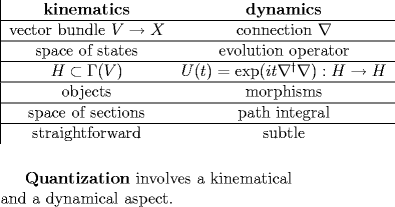The First Part of the Story of Quantizing by Pushing to a Point…
Posted by Urs Schreiber
…in which the author entertains himself by computing the space of states of a charged particle by pushing its parallel transport forward to a point. Just for fun.
Let
be a space and let
be vector bundle over with connection
Equivalently this means # that we have a locally smoothly trivializable functor
that sends paths in to the parallel transport along them obtained from the connection .
Quantizing the single particle charged under this bundle with connection consists of a kinematical and of a dynamical aspect:

In this first part of the story we amuse ourselves by just doing the trivial kinematics – but in a nice way.
So, let’s forget the connection immediatey by just looking at constant paths in . I’ll write
for the above functor restricted to constant paths, ie. to the discrete category over . It does nothing but sending each point in to the vector space sitting over it – but smoothly so.
We can play the same game on the base space
that consists of nothing but a single point.
A trivial rank one vector bundle over a point is a functor
that does nothing but sending the single point to the complex numbers:
I admit that I am presupposing a certain tolerance for fancy-looking trivialities here. But enduring these will pay off eventually.
Using the uniqe functor from to the point
we can pull back the trivial vector bundle over the point to . The result
is the trivial rank one bundle on . This functor simply sends each point of the typical fiber :
In as far as any of this is interesting at all, it is for the following simple fact:
a morphism of functors:
is precisely a section of the vector bundle : is nothing but an assignment
of a linear map from to the fiber for each point . That’s nothing but a choice of vector in each fiber.
So, the space of all such functor morphisms
from the trivial one into the one defining our vector bundle is nothing but the space of sections of .
Since is a vector space, and since vector bundles over the point are nothing but vector spaces, I want to think of as a vector bundle over the point. So I regard it as a functor
On top of all these trivialities, I’ll finally allow mysef to think of as morphisms from the trivial line bundle on the point into this guy:
The upshot is that, taken together, we get the isomorphism
If you like, you can convince yourself that this isomorphism of Hom-spaces in indeed natural in both arguments. But this means that pulling back functors from points to
is the adjoint of taking sections
This, in turn, says that forming the space of sections of is the result of pushing forward to a point.
Of course that’s neither new nor very deep. But part of a nice story that still needs to be told.
